Indian Express Explained
Stay informed with simplified explanations of complex news stories and current affairs that matter for your UPSC preparation.
Featured Explanation
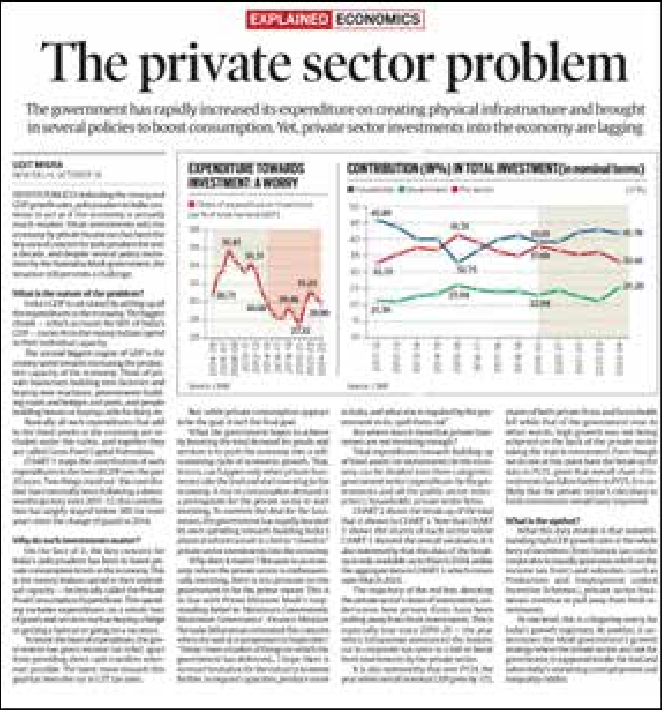
THE PRIVATE SECTOR PROBLEM
India’s government has been spending heavily on infrastructure — roads, railways, digital projects — to boost economic growth. However, private sector investment (by businesses and households) has not picked up at the same pace. This imbalance raises a big question: Why is the private sector not investing enough, even when the economy is growing strongly?
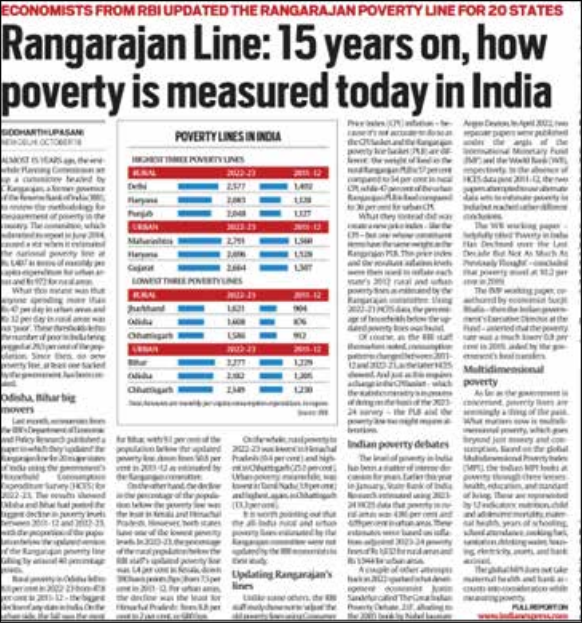
RANGARAJAN LINE: 15 YEARS ON – HOW POVERTY IS MEASURED TODAY IN INDIA
India’s poverty measurement system has been updated after more than a decade. Economists from the Reserve Bank of India (RBI) have recalculated the Rangarajan Poverty Line for 20 states, using the latest inflation and price data (2022–23).

A Leap in the Skies – LCA Tejas Mk1A’s First Flight and India’s Self-Reliance Drive
The inaugural flight of the Light Combat Aircraft (LCA) Tejas Mk1A at the Hindustan Aeronautics Limited (HAL) facility in Nashik on October 17 marked a historic step in India’s defence indigenisation journey. Defence Minister Rajnath Singh called the flight a “shining symbol of India’s self-reliance in defence manufacturing,” aligning with the broader Atmanirbhar Bharat vision and the goal to make India a net defence exporter by 2030.

Engagement without Recognition India’s Evolving Approach to the New Afghanistan
India has recently reopened its Embassy in Kabul after over a year of limited presence, marking a cautious yet strategic re-engagement with Afghanistan’s Taliban-led government without formally recognising it. This step represents India’s attempt to balance diplomatic pragmatism, regional security interests, and humanitarian commitments, while maintaining consistency with its stance on non-recognition of regimes formed through force.
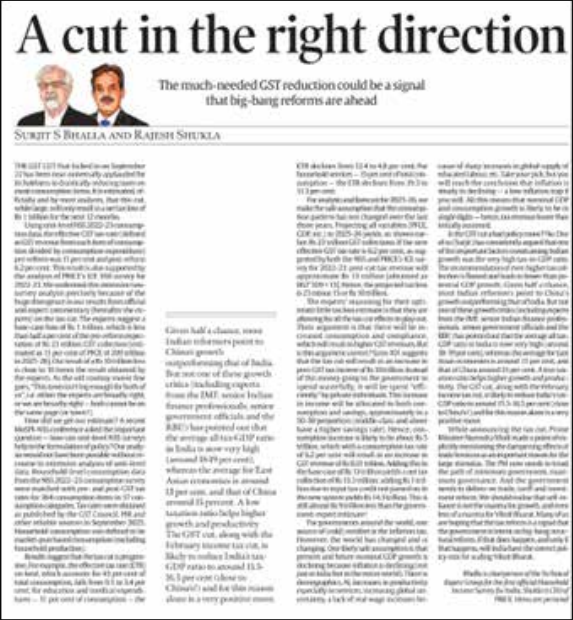
A Cut in the Right Direction – GST Rate Reduction & Economic Reform Momentum
The Union Government’s recent Goods and Services Tax (GST) rate reduction marks a crucial fiscal and policy move to revive consumption, ease inflationary pressures, and restore reform confidence. The editorial by Surjit Bhalla and Rajesh Shukla argues that this reduction is not merely a tax tweak, but a signal of larger economic reform intent, potentially ushering in the next wave of big-bang economic reforms.
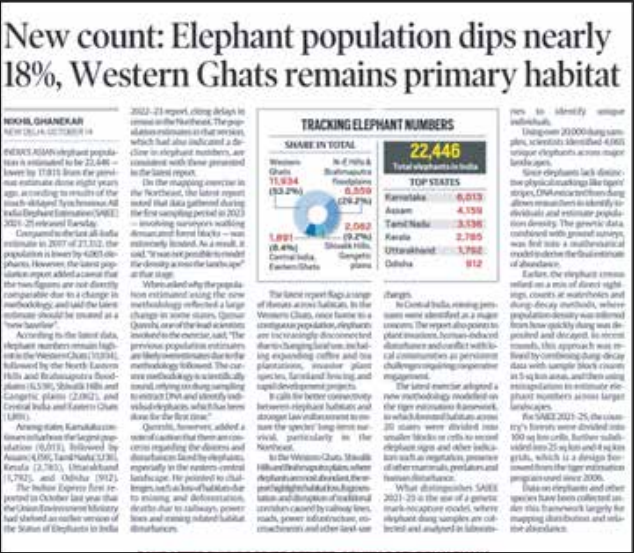
India’s Elephant Census 2024 Decline in Numbers, Shifting Habitats
The 2024 edition of the All India Elephant Estimation (AIEE) — part of the Synchronous All India Elephant Estimation (SAIE) 2021–25 — has reported a 17.8% fall in India’s Asian elephant population, now estimated at 22,446 individuals. The census, conducted by the Ministry of Environment, Forest and Climate Change (MoEFCC), highlights changing habitat dynamics, delays in field surveys, and continued human–elephant conflict. Despite the decline, the Western Ghats remain India’s primary elephant habitat, hosting more than half (53%) of the total population.
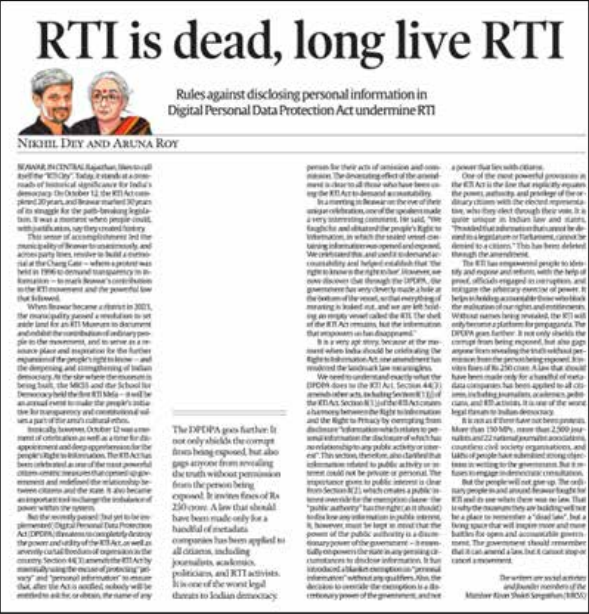
RTI is Dead, Long Live RTI
The editorial highlights the gradual weakening of India’s Right to Information (RTI) Act, once celebrated as a foundation of participatory democracy. It argues that the spirit of transparency and accountability that empowered ordinary citizens is being eroded by government apathy, institutional capture, and delays. At the same time, it calls for a citizen-led revival to protect the democratic right to know.

The Grain of Ethanol Production: India’s Biofuel Shift from Sugar to Grain
India’s Ethanol Blending Programme (EBP), once primarily designed to assist sugarcane farmers by absorbing surplus molasses, has undergone a structural transformation. Recent data show that the programme has attracted over ₹40,000 crore in private investment and has increasingly benefited standalone grain-based ethanol manufacturers, marking a major policy and industrial shift in India’s biofuel landscape. This shift coincides with India’s broader push toward energy security, import substitution, and rural industrialization, as the government targets 20% ethanol blending (E20) in petrol by 2025–26.

India Notifies First Legally Binding Emission Cut Targets for Four Sectors
India has taken a major step toward meeting its climate commitments under the Paris Agreement (2015) by notifying the first legally binding emission reduction targets for key industrial sectors. The notification marks a shift from voluntary pledges to mandatory climate action, aimed at reducing the country’s greenhouse gas (GHG) emissions and developing a domestic carbon market.
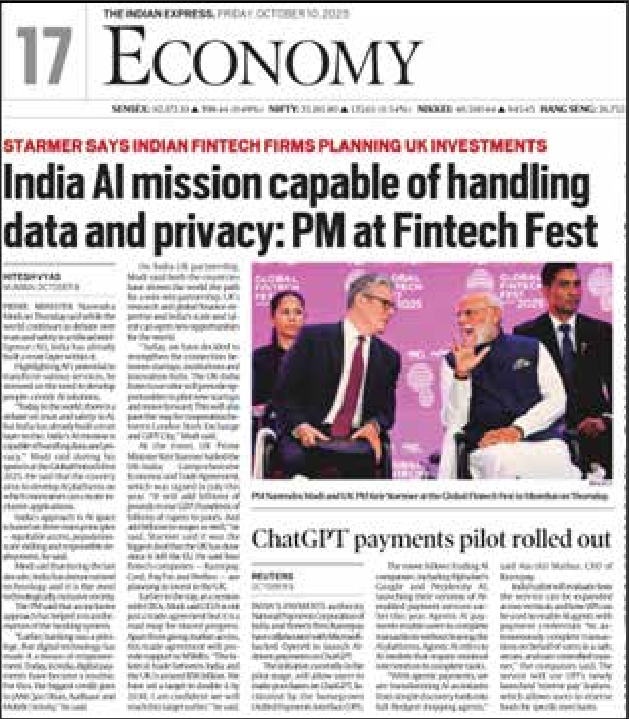
India’s AI Mission: Balancing Innovation, Data, and Privacy
As artificial intelligence (AI) reshapes global economies, India is stepping forward with an ambitious vision — to lead responsibly in this transformative era. At the Global Fintech Fest 2025 in Mumbai, Prime Minister Narendra Modi emphasized that India’s upcoming AI Mission will not only drive innovation but also ensure robust mechanisms for data protection and privacy.
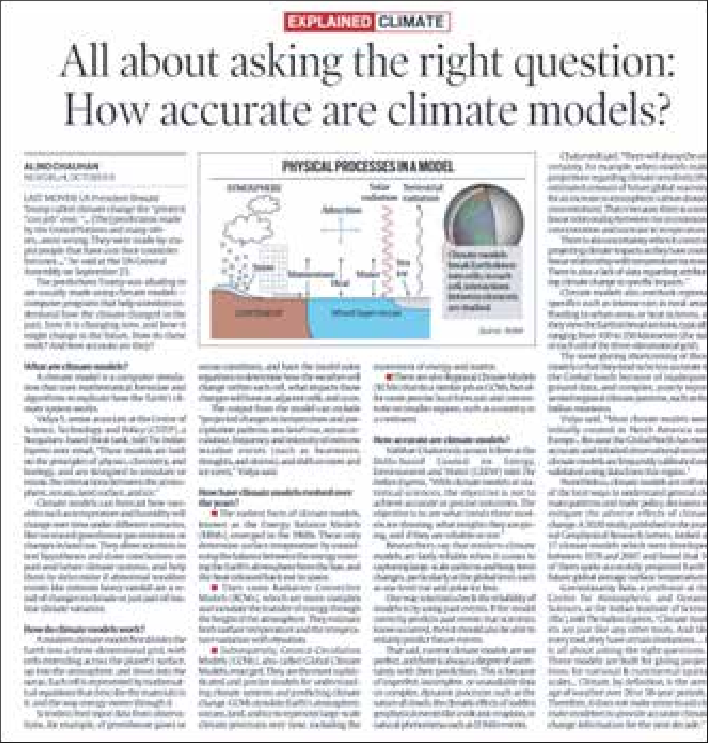
All about asking the right question: How accurate are climate models?
As global temperatures continue to rise, scientists are refining climate models to better predict extreme weather events, sea-level rise, and temperature patterns. A recent discussion highlights how these models work and why asking the right questions matters as much as the data itself.
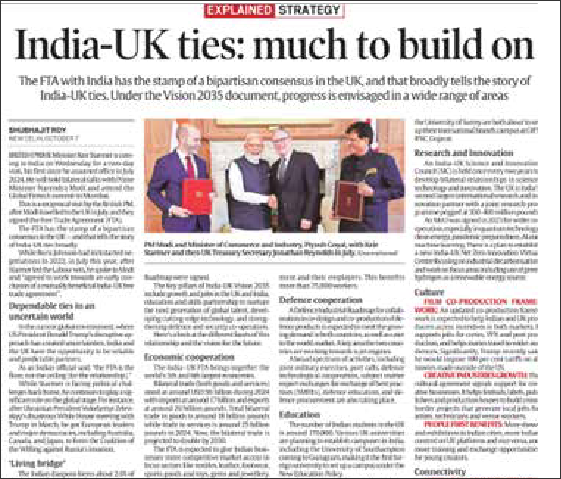
India-UK Ties: Much to Build On
During UK Prime Minister Keir Starmer’s first visit to India in October 2025, both nations reaffirmed their commitment to strengthening the India–UK Comprehensive Strategic Partnership under the Vision 2035 framework. Talks centered on the long-pending Free Trade Agreement (FTA) and collaboration in defence, education, technology, and innovation.

2025 Nobel Prize in Physiology or Medicine: Why the Immune System Doesn’t Attack the Body
The 2025 Nobel Prize in Physiology or Medicine has been awarded to Shimon Sakaguchi (Japan), Mary E. Brunflow (USA), and Frederick Ramsdell (USA) for uncovering how the human immune system distinguishes “self” from “non-self.”
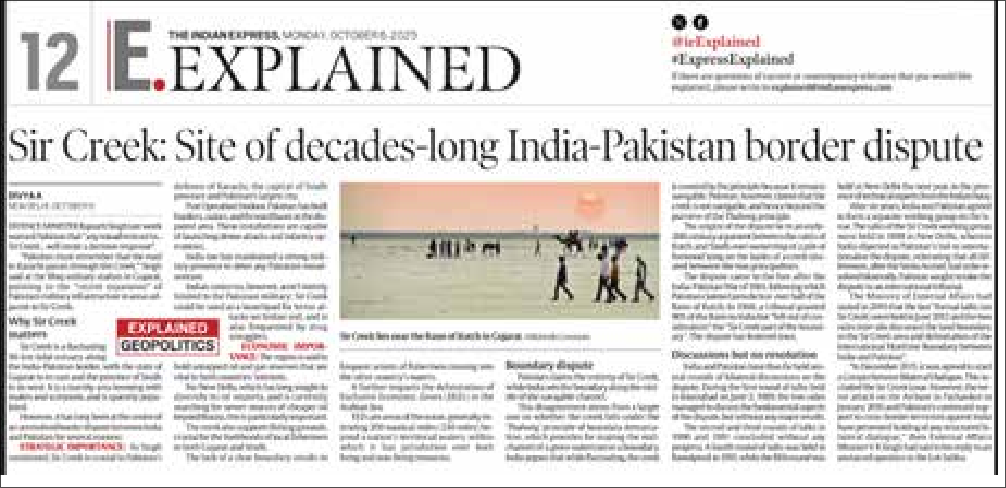
Sir Creek: Site of Decades-long India–Pakistan Border Dispute
As tensions simmer along the India–Pakistan maritime boundary, Defence Minister Rajnath Singh’s recent statement warning Pakistan against “any misadventure” in the Sir Creek region has refocused attention on one of South Asia’s oldest yet unresolved territorial disputes.
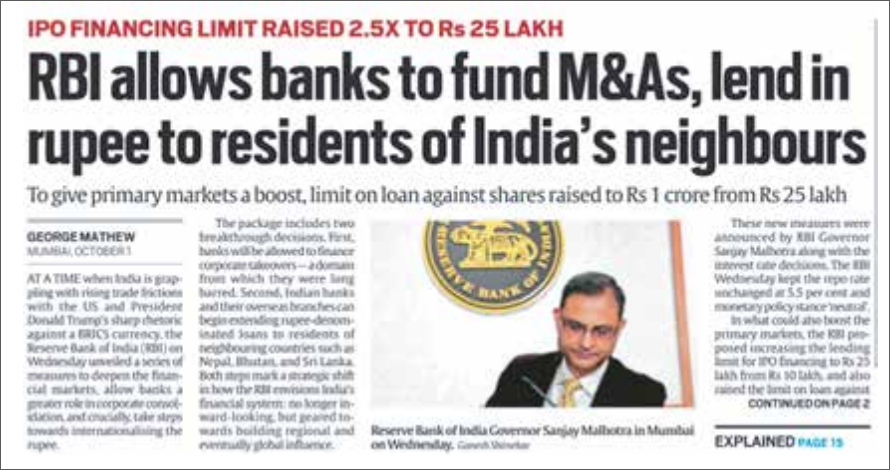
RBI’s New Measures: Funding M&As and Lending Rupee Abroad
The Reserve Bank of India has announced breakthrough reforms allowing banks to finance M&As and extend rupee loans to neighbouring countries like Nepal, Bhutan, and Sri Lanka. These steps mark a shift from domestic focus to strengthening the rupee's role in regional and global finance.

Trump's Gaza Peace Plan: Can it really bring lasting peace to West Asia?
Analyzing former U.S. President Donald Trump's 20-point Gaza Peace Plan promising ceasefire, hostage release, reconstruction, and a path to "New Gaza" as a special economic zone. Can this plan truly resolve one of the world's most intractable conflicts?

The Wassenaar Arrangement: the need to reform export control regimes
Understanding the challenges of controlling exports in the digital age. Traditional export control regimes were built for tangible items, but today's exports often take the form of cloud services, AI tools, and surveillance software delivered remotely.
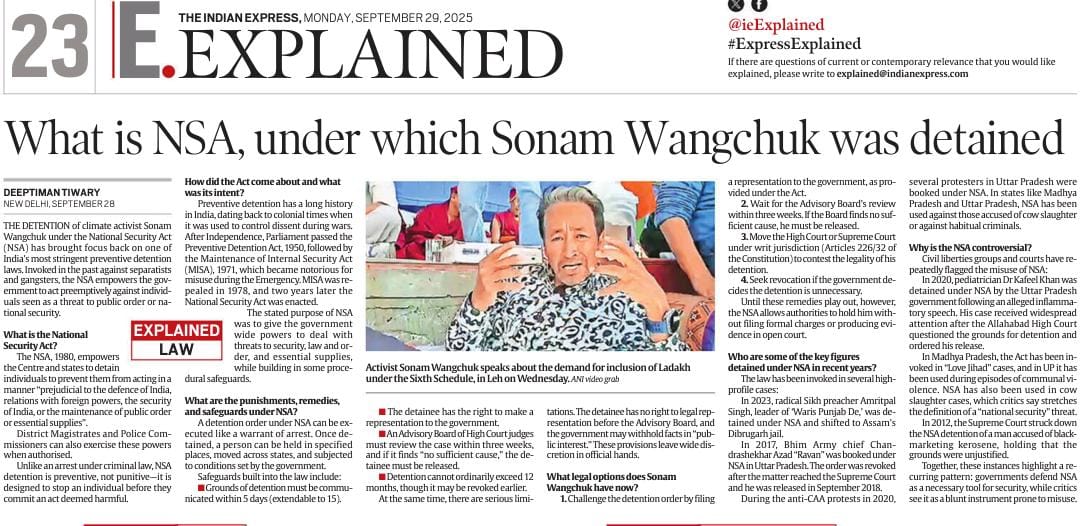
What is NSA, under which Sonam Wangchuk was detained
Understanding the National Security Act (NSA) under which climate activist Sonam Wangchuk was detained. This explanation covers the Act's provisions, its history, preventive detention powers, and the legal procedures involved.